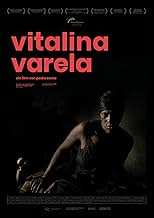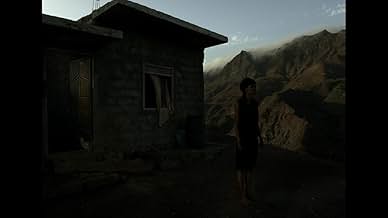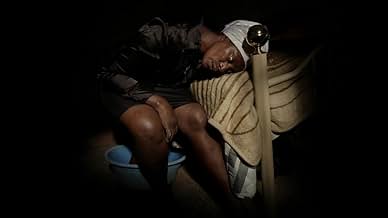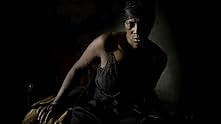Vitalina Varela
- 2019
- Tous publics
- 2h 4m
IMDb RATING
6.7/10
2.6K
YOUR RATING
A Cape Verdean woman navigates her way through Lisbon, following the scanty physical traces her deceased husband left behind and discovering his secret, illicit life.A Cape Verdean woman navigates her way through Lisbon, following the scanty physical traces her deceased husband left behind and discovering his secret, illicit life.A Cape Verdean woman navigates her way through Lisbon, following the scanty physical traces her deceased husband left behind and discovering his secret, illicit life.
- Director
- Writers
- Stars
- Awards
- 24 wins & 29 nominations total
- Director
- Writers
- All cast & crew
- Production, box office & more at IMDbPro
Featured reviews
I watched this movie praised by most critics for its beauty. And it is a beautiful shot movie because of mis-e- scene, acting, lightning and camera. It is all superb in its self inflicted-limitations. Very simple mis-en=.scene and dressing of mostly very poor slum interiors, all shot at night. Fascinating acting of the woman Vitalina who's face is so great to look at in the many close ups. The lightning which makes with its claire obscure and brilliant color accents everything into a Carravagio painting. And the camera which chooses always a fixed cadre like a painting and gets the light and colors in a subtle way. There is hardly a story cause there is no development. It is more the depiction of the failed life of the just died husband of Vitalina, told to us through her eyes, her monologues, searching for details and questions to the priest who buried him. In one scene the husband is shown seen on his slender young naked back lying in the matrimonial bed still in Cabo Verdi. The now young wife Vitalina stands up and walks out of their self build house into a beautiful but dry landscape.
The general theme of the movie is the misery of life in general and that of Cabe Verdian migrant workers in particular. My question watching the movie was and is what is the function of all this beauty, what is it for? Is it to show that allthough life is miserable the figures in this movie experience it as beautiful? The answer is negative cause they are desperate in their life and see no light. Is the beauty meant to soften our experience of viewing all this malheur? Of course it does. How to watch so much ugliness for such a long time if there is not something nice to be seen? It has that softening and pleasurable effect but it is not the main function of all this esthetica . I think the function is deeper. Is it l'art pour l'art: beauty for beauty sake? Maybe but what does that mean here? I think that in a religious way we are shown the deep humanity of all these unlucky and unhappy people and the possibility to reconcile ourselves through this beauty with human life. At least I think it is meant that way by the maker of the movie. Did it work that way with me? In a way yes but not in a satisfactory way. Maybe that's my fault.
A poignant story in an extraordinary setting, shown in a poetic, serene way.
Gorgeous cinematography, shot in a clair-obscur style which highlights certain distinct colours from the darkness (at times reminiscent of old masters's paintings, such as the work of Caravaggio or Rembrandt).
Strong, pure acting by the lead actors - Vitalina Varela and Ventura.
Pedro Costa tells his story slowly, but intelligently. Instead of presenting the plot outline on a silver platter, he challenges the viewer to discover this for himself. Costa's style of story-telling reminds me of Bela Tarr's films; both prefer the visual language over the spoken one.
This film is not very accessible, and requires full attention. But it will prove to be very rewarding in the end.
Gorgeous cinematography, shot in a clair-obscur style which highlights certain distinct colours from the darkness (at times reminiscent of old masters's paintings, such as the work of Caravaggio or Rembrandt).
Strong, pure acting by the lead actors - Vitalina Varela and Ventura.
Pedro Costa tells his story slowly, but intelligently. Instead of presenting the plot outline on a silver platter, he challenges the viewer to discover this for himself. Costa's style of story-telling reminds me of Bela Tarr's films; both prefer the visual language over the spoken one.
This film is not very accessible, and requires full attention. But it will prove to be very rewarding in the end.
Superb use of sound and camera, fascinating performances. My first Pedro Costa film--what a joy to view it. Reminded of Sokurov's "Mother and Son"--had he made it, it would be probably titled "Wife and Husband." This Pedro Costa film is definitely one of my best 2019 films. Winner of Golden Leopard and the Best Actress awards at Locarno film festival. Well deserved!
The islands of Cabo Verde (Cape Verde), in the Atlantic, 600 km west of the Senegal coast were a Portuguese colony until 1975. As a country, they enjoy the dubious distinction of having more of its citizens living abroad (700,000) than at home (560,000), which reflects the lack of job opportunities. In particular, about 100,000 live in Portugal, most of them eking out a living out of low paying jobs.
The scenario is Cova da Moura, a suburb of Lisbon, whose inhabitants are 75% from Cape Verde. Its houses were constructed by the locals, without the benefit of a permit. It is an urban island without open spaces, with streets of random widths and serious crime problems,
The main character is Vitalina Varela (played by herself), Her husband Joaquim left her (and his homeland) 25 years ago in search of better opportunities. He settled in Cova da Moura, where he built a precarious house, with insufficient light, crumbling walls, leaking roof and untiled floor (he and Vitalina had constructed a cheerful, airy house back home). Vitalina hears no more of him until she is informed that Joaquim has taken ill. She flies to Lisbon but arrives three days after the funeral. She learns about Joaquim's life from various dwellers of the shantytown. She also reconnects with a priest that she knew from the islands.
This is it. Director Pedro Costa tells the tale in a rather peculiar way. The pace is slow, sometimes excruciatingly so. Every shot by cinematographer Leonardo Simões is carefully composed; the lighting is unabashedly artificial and produces chiaroscuro scenes that, of course, remind one of Caravaggio. Crumbling cement walls, squalid interiors and unpaved lanes take a three dimensional quality and a life of their own. We don't see the shantytown as the locals see it but through the eye of a painter. We all "know" that excessively elaborate cinematography may interfere with the tale being told, but the director stands this rule on end. The final result is worth watching, even if only for the visuals.
The scenario is Cova da Moura, a suburb of Lisbon, whose inhabitants are 75% from Cape Verde. Its houses were constructed by the locals, without the benefit of a permit. It is an urban island without open spaces, with streets of random widths and serious crime problems,
The main character is Vitalina Varela (played by herself), Her husband Joaquim left her (and his homeland) 25 years ago in search of better opportunities. He settled in Cova da Moura, where he built a precarious house, with insufficient light, crumbling walls, leaking roof and untiled floor (he and Vitalina had constructed a cheerful, airy house back home). Vitalina hears no more of him until she is informed that Joaquim has taken ill. She flies to Lisbon but arrives three days after the funeral. She learns about Joaquim's life from various dwellers of the shantytown. She also reconnects with a priest that she knew from the islands.
This is it. Director Pedro Costa tells the tale in a rather peculiar way. The pace is slow, sometimes excruciatingly so. Every shot by cinematographer Leonardo Simões is carefully composed; the lighting is unabashedly artificial and produces chiaroscuro scenes that, of course, remind one of Caravaggio. Crumbling cement walls, squalid interiors and unpaved lanes take a three dimensional quality and a life of their own. We don't see the shantytown as the locals see it but through the eye of a painter. We all "know" that excessively elaborate cinematography may interfere with the tale being told, but the director stands this rule on end. The final result is worth watching, even if only for the visuals.
Pedro is very well know outside the country he lives and films on, not that much in the country he actually lives, the country I also live. I think the reason for that is, one: the films are complicated, and two: his filming a reality people don't know and don't want to see. There's a lot of people that don't really understand what "his" saying, and I can't blame them, because I also don't understand, in some, a large portion of it, Pedro himself says he doesn't either. To watch "his" films I ask for the company of my mother. She explains the films to me, a rare occasion for her, because she's accustomed to being me doing the movie explanations. She's seeing a reality she lived 50 years ago, right after the 1974 revolution, a revolution made only for some.
Did you know
- TriviaOfficial submission of Portugal for the 'Best International Feature Film' category of the 93rd Academy Awards in 2021.
- ConnectionsSpin-off from Ventura (2014)
- How long is Vitalina Varela?Powered by Alexa
Details
Box office
- Gross US & Canada
- $14,941
- Opening weekend US & Canada
- $4,612
- Feb 23, 2020
- Gross worldwide
- $56,860
- Runtime
- 2h 4m(124 min)
- Color
- Aspect ratio
- 1.33 : 1
Contribute to this page
Suggest an edit or add missing content




















